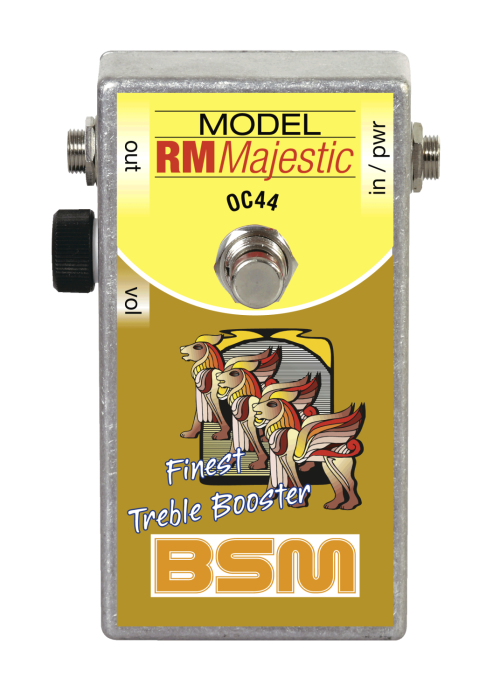
BSM RM Majestic Treble Booster
The BSM Majestic model is based on the British Range Master unit produced between 1965 and 1969, as used by Eric Clapton in John Mayall"s Bluesbreakers. Eric also used the booster when playing in the legendary group Cream. Its biting, powerful sound is clearly in evidence on the Bluesbreakers "Beano" album. Blues rocker Rory Gallagher, Glam rocker Mark Bolan, Heavy Rock pioneer Tony Iommi and Brian May from Queen were also heavy users of the original Range Master unit. The long yearned for new edition, now issued under the name RM from BSM, includes the same OC44 germanium transistors as the the original 1965 version.
The RM Majestic is the BSM top-of-the-line treble booster model. It is also loaded with the vintage OC44 transistor but from a much higher selection. Those special OC44 transistors are out of a high grade selection stash, very hard to find, but BSM managed to get a very small amount of this industrial highly-selected OC44 transistors from Valvo and Philips. Those are from 1959 and were meant to use inside professional measuring instruments (Siemens wobble-generator for SW, LW and MW). The RM Majestic is much more transparent than the stock RM model with an unheard richness of details in your sound, the perfect mate for your pedalboard if the best is even good enough. In comparison with the standard RM the Majestic delivers also 4dB more gain and more headroom.
Almost all British rock guitarists using single coil pickup guitars used a germanium Treble Booster from the late 60's to the mid 70's. By the end of the seventies, the Treble Booster was replaced by a new circuit from Japan, the so called Tube Screamer and other similar overdrive circuits. These were based on the old Treble Boosters and therefore had a very similar frequency response. The germanium boosters on the other hand, sadly fell into oblivion despite their unique and inimitable sound. The RM Treble Booster has been specifically designed for single coil and humbucking pickups with a relatively low/medium inductance, such as pickups in Fender, Gretsch, Burns or Gibson guitars. On these pickups, the RM produces (with the volume control of the guitar turned up to the max) a fat, biting and penetrating lead sound, minus any shrill characteristics. By lowering the guitar's volume control, many shades of crunch can be easily dialed in. Another thing to consider is that when a guitar amp's volume is turned up (reaching saturation), the power amp normally begins to mute the highs, which results in a duller sound. At an amp's full tilt, the RM Treble Booster allows a more transparent tone (covering the entire frequency range) to shine through. The presence control on the amp need only be minimally used (if at all). When vintage amps are used (such as the Fender Deluxe, Fender Bassman, Vox AC30, Marshall JTM 45 or Marshall Plexi) it is amazing what effect the use of a good treble booster has. It is also of interest to note that Eric Clapton used a new 2 x12" Marshall combo (Model 1962 with KT66 output tubes) with the Bluesbreakers, and 100 Watt Plexi heads with Cream. Brian May used a couple of VOX AC30 combos with the RM in front of the "Normal" channel.
The Treble Booster is inserted between guitar and amplifier, not into the FX loop. The magical tone is achieved by the interaction between guitar pickup, treble booster and amplifier. The unit is powered by a 9V battery with a current consumption of approx. 250 uA. The average output level is 10dBm, the maximum output voltage when the strings are struck really hard is 7V max. Note: The positive pole of the battery is ground. By turning the volume pot, the special circuit design makes noises - just like the orginal does!
